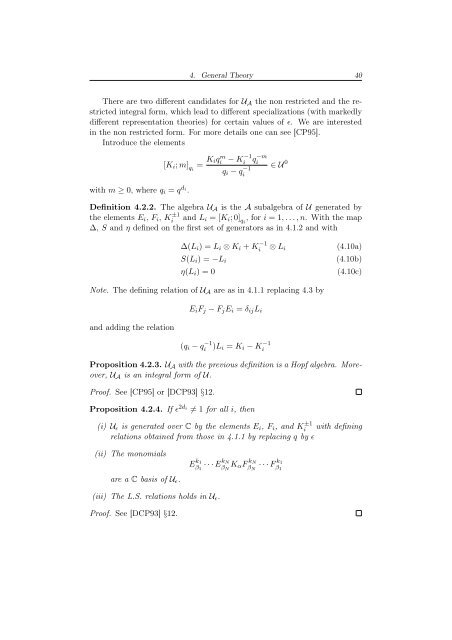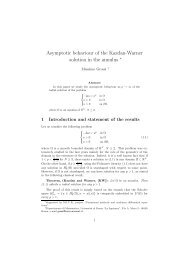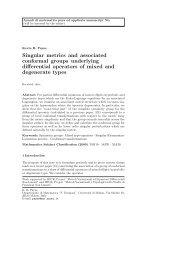Degree of Parabolic Quantum Groups - Dipartimento di Matematica ...
Degree of Parabolic Quantum Groups - Dipartimento di Matematica ...
Degree of Parabolic Quantum Groups - Dipartimento di Matematica ...
Create successful ePaper yourself
Turn your PDF publications into a flip-book with our unique Google optimized e-Paper software.
4. General Theory 40<br />
There are two <strong>di</strong>fferent can<strong>di</strong>dates for UA the non restricted and the restricted<br />
integral form, which lead to <strong>di</strong>fferent specializations (with markedly<br />
<strong>di</strong>fferent representation theories) for certain values <strong>of</strong> ǫ. We are interested<br />
in the non restricted form. For more details one can see [CP95].<br />
Introduce the elements<br />
with m ≥ 0, where qi = q <strong>di</strong> .<br />
[Ki; m] qi = Kiq m i<br />
− K−1<br />
i q−m<br />
i<br />
qi − q −1<br />
i<br />
∈ U 0<br />
Definition 4.2.2. The algebra UA is the A subalgebra <strong>of</strong> U generated by<br />
the elements Ei, Fi, K ±1<br />
i and Li = [Ki; 0] , for i = 1, . . .,n. With the map<br />
qi<br />
∆, S and η defined on the first set <strong>of</strong> generators as in 4.1.2 and with<br />
∆(Li) = Li ⊗ Ki + K −1<br />
i ⊗ Li (4.10a)<br />
S(Li) = −Li<br />
(4.10b)<br />
η(Li) = 0 (4.10c)<br />
Note. The defining relation <strong>of</strong> UA are as in 4.1.1 replacing 4.3 by<br />
and ad<strong>di</strong>ng the relation<br />
EiFj − FjEi = δijLi<br />
(qi − q −1<br />
i )Li = Ki − K −1<br />
i<br />
Proposition 4.2.3. UA with the previous definition is a Hopf algebra. Moreover,<br />
UA is an integral form <strong>of</strong> U.<br />
Pro<strong>of</strong>. See [CP95] or [DCP93] §12.<br />
Proposition 4.2.4. If ǫ 2<strong>di</strong> = 1 for all i, then<br />
(i) Uǫ is generated over C by the elements Ei, Fi, and K ±1<br />
i with defining<br />
relations obtained from those in 4.1.1 by replacing q by ǫ<br />
(ii) The monomials<br />
are a C basis <strong>of</strong> Uǫ.<br />
E k1<br />
β1<br />
(iii) The L.S. relations holds in Uǫ.<br />
Pro<strong>of</strong>. See [DCP93] §12.<br />
kN k1<br />
· · ·EkN KαF · · ·F βN βN β1








